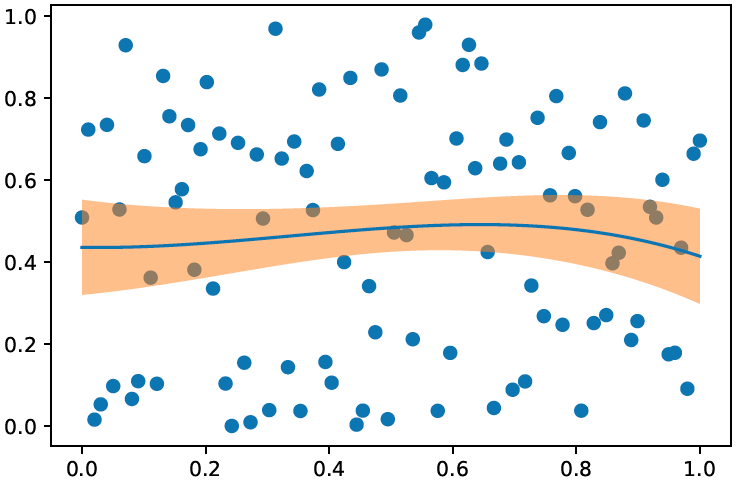Seaborn's creator has unfortunately stated that he won't add such a feature. Below are some options. (The last section contains my original suggestion, which was a hack that used private implementation details of seaborn and was not particularly flexible.)
Simple alternative version of regplot
The following function overlays a fit line on a scatter plot and returns the results from statsmodels. This supports the simplest and perhaps most common usage for sns.regplot, but does not implement any of the fancier functionality.
import statsmodels.api as sm
def simple_regplot(
x, y, n_std=2, n_pts=100, ax=None, scatter_kws=None, line_kws=None, ci_kws=None
):
""" Draw a regression line with error interval. """
ax = plt.gca() if ax is None else ax
# calculate best-fit line and interval
x_fit = sm.add_constant(x)
fit_results = sm.OLS(y, x_fit).fit()
eval_x = sm.add_constant(np.linspace(np.min(x), np.max(x), n_pts))
pred = fit_results.get_prediction(eval_x)
# draw the fit line and error interval
ci_kws = {} if ci_kws is None else ci_kws
ax.fill_between(
eval_x[:, 1],
pred.predicted_mean - n_std * pred.se_mean,
pred.predicted_mean + n_std * pred.se_mean,
alpha=0.5,
**ci_kws,
)
line_kws = {} if line_kws is None else line_kws
h = ax.plot(eval_x[:, 1], pred.predicted_mean, **line_kws)
# draw the scatterplot
scatter_kws = {} if scatter_kws is None else scatter_kws
ax.scatter(x, y, c=h[0].get_color(), **scatter_kws)
return fit_results
The results from statsmodels contain a wealth of information, e.g.:
>>> print(fit_results.summary())
OLS Regression Results
==============================================================================
Dep. Variable: y R-squared: 0.477
Model: OLS Adj. R-squared: 0.471
Method: Least Squares F-statistic: 89.23
Date: Fri, 08 Jan 2021 Prob (F-statistic): 1.93e-15
Time: 17:56:00 Log-Likelihood: -137.94
No. Observations: 100 AIC: 279.9
Df Residuals: 98 BIC: 285.1
Df Model: 1
Covariance Type: nonrobust
==============================================================================
coef std err t P>|t| [0.025 0.975]
------------------------------------------------------------------------------
const -0.1417 0.193 -0.735 0.464 -0.524 0.241
x1 3.1456 0.333 9.446 0.000 2.485 3.806
==============================================================================
Omnibus: 2.200 Durbin-Watson: 1.777
Prob(Omnibus): 0.333 Jarque-Bera (JB): 1.518
Skew: -0.002 Prob(JB): 0.468
Kurtosis: 2.396 Cond. No. 4.35
==============================================================================
Notes:
[1] Standard Errors assume that the covariance matrix of the errors is correctly specified.
A drop-in replacement (almost) for sns.regplot
The advantage of the method above over my original answer below is that it's easy to extend it to more complex fits.
Shameless plug: here is such an extended regplot function that I wrote that implements a large fraction of sns.regplot's functionality: https://github.com/ttesileanu/pydove.
While some features are still missing, the function I wrote
- allows flexibility by separating the plotting from the statistical modeling (and you also get easy access to the fitting results).
- is much faster for large datasets because it lets
statsmodels calculate confidence intervals instead of using bootstrapping.
- allows for slightly more diverse fits (e.g., polynomials in
log(x)).
- allows for slightly more fine-grained plotting options.
Old answer
Seaborn's creator has unfortunately stated that he won't add such a feature, so here's a workaround.
def regplot(
*args,
line_kws=None,
marker=None,
scatter_kws=None,
**kwargs
):
# this is the class that `sns.regplot` uses
plotter = sns.regression._RegressionPlotter(*args, **kwargs)
# this is essentially the code from `sns.regplot`
ax = kwargs.get("ax", None)
if ax is None:
ax = plt.gca()
scatter_kws = {} if scatter_kws is None else copy.copy(scatter_kws)
scatter_kws["marker"] = marker
line_kws = {} if line_kws is None else copy.copy(line_kws)
plotter.plot(ax, scatter_kws, line_kws)
# unfortunately the regression results aren't stored, so we rerun
grid, yhat, err_bands = plotter.fit_regression(plt.gca())
# also unfortunately, this doesn't return the parameters, so we infer them
slope = (yhat[-1] - yhat[0]) / (grid[-1] - grid[0])
intercept = yhat[0] - slope * grid[0]
return slope, intercept
Note that this only works for linear regression because it simply infers the slope and intercept from the regression results. The nice thing is that it uses seaborn's own regression class and so the results are guaranteed to be consistent with what's shown. The downside is of course that we're using a private implementation detail in seaborn that can break at any point.

